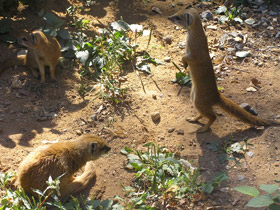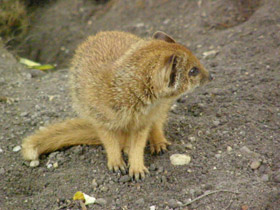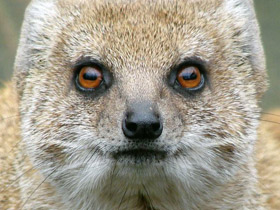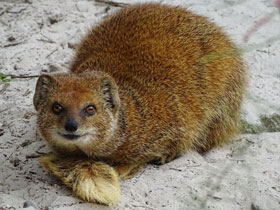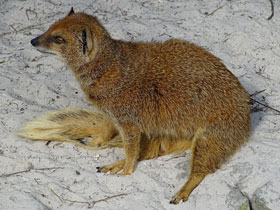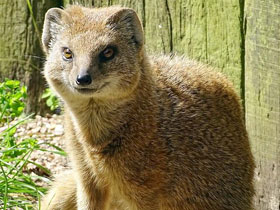The yellow mongoose or the red meerkat (Cynictis penicillata)
Yellow mongoose видео
The yellow mongoose (Cynictis penicillata), sometimes referred to as the red meerkat, is a member of the mongoose family. It averages about 0.45 kg (1 lb) in weight and about 510 mm (20 in) in length. It lives in open country, semi-desert scrubland and grasslands in Angola, Botswana, South Africa, Namibia, and Zimbabwe. It is the only species in the genus Cynictis.
Taxonomy
Herpestes penicillatus was the scientific name proposed by Georges Cuvier in 1829 for a mongoose specimen from the Cape. The generic name Cynictis was proposed by William Ogilby in 1833 for a specimen collected in Kaffraria. Cynictis penicillata is the only member of the genus, but as manyas twelve subspecies of yellow mongoose have been described.
Description and distribution
Cynictis penicillata is a species of carnivorous mammal belonging to the family Herpestidae. It is the only member of the genus Cynictis.
Cynictis penicillata is endemic to South Africa and is found in South Africa, Namibia, Botswana, Zimbabwe and southern Angola, and is one of the most common inhabitants of savannahs, semi-deserts and scrublands.
This animal owes its name to its yellow-red colour (in some languages it is even called fox mongoose). These mongooses even look different in the different seasons (just like our foxes): in summer their fur is reddish, short and fine, and in winter its colour fades, but it becomes thick, long and smooth. The short, rounded ears and fluffy tail increase the resemblance to the fox, but its size is much more modest: body length is 27-38 cm and weight 440-800 g (the length of the tail is almost equal to that of the body and reaches 18-28 cm).
Lifestyle and peculiarities
These animals are active during the day, but remain in their burrows at night. Cynictis penicillata digs excellent burrows, but often occupies the burrows of other animals, e.g. moles or long-eared vultures. They sometimes inhabit burrows together with moles. Cynictis penicillata is a social animal, living in family groups of 5 to 20 animals. The core of the colony consists of an adult breeding pair and their young, as well as semi-adult or adult pairs; the other members of the family are not closely related to the core. The burrows of the colony members are clustered around the burrow of the alpha pair. The sites of the males overlap each other. Every day the alpha male marks the members of the family group with anal gland secretion, the site boundaries with anal and facial gland secretion and urine, and rubs his back on objects on high ground, leaving his fur on them as a visual territory marker. The other members of the group mark their burrows with the secretion of their cheek glands.
Social behaviour, nutrition, reproduction
Cynictis penicillata lives in colonies in intricately constructed underground tunnels, linked together and covering an area of up to 50 m2. To conceal the entrance to the burrow, they bury their droppings in secluded places. When food is scarce, Cynictis penicillata (and sometimes a whole colony) may migrate in search of a new home. These small but very agile predators feed on rodents, birds and their eggs, reptiles and amphibians, but most of their food consists of insects and their larvae (beetles, termites, locusts, ants). Occasionally they eat cereals and seeds of various plants.
When feeding, Cynictis penicillata do not usually stray far from their burrows and hide in them immediately at the slightest sign of danger. Once or twice a year, after a gestation period of 60 days, the female gives birth to one to four young in a burrow without bedding. The mother feeds her cubs on milk for about 10 weeks, but from 6 weeks of age they begin to try solid food.
Cynictis penicillata reach sexual maturity at the age of 1 year. If a young Cynictis penicillata (less than 10 months old) enters a foreign territory, it adopts a submissive posture by lying on its side.
Predators
Predators of the yellow mongoose are birds of prey, snakes and jackals. When frightened, the yellow mongoose will growl and secrete from its anal glands. It can also scream, bark, and purr, though these are exceptions, as the yellow mongoose is usually silent, and communicates mood and status through tail movements.
Rabies
There is some concern about the yellow mongoose's role as a natural reservoir of rabies. Most African wild animals die within several weeks of infection with rabies, but it seems that certain genetic strains of the yellow mongoose can carry it asymptomatically, but infectiously, for years.









